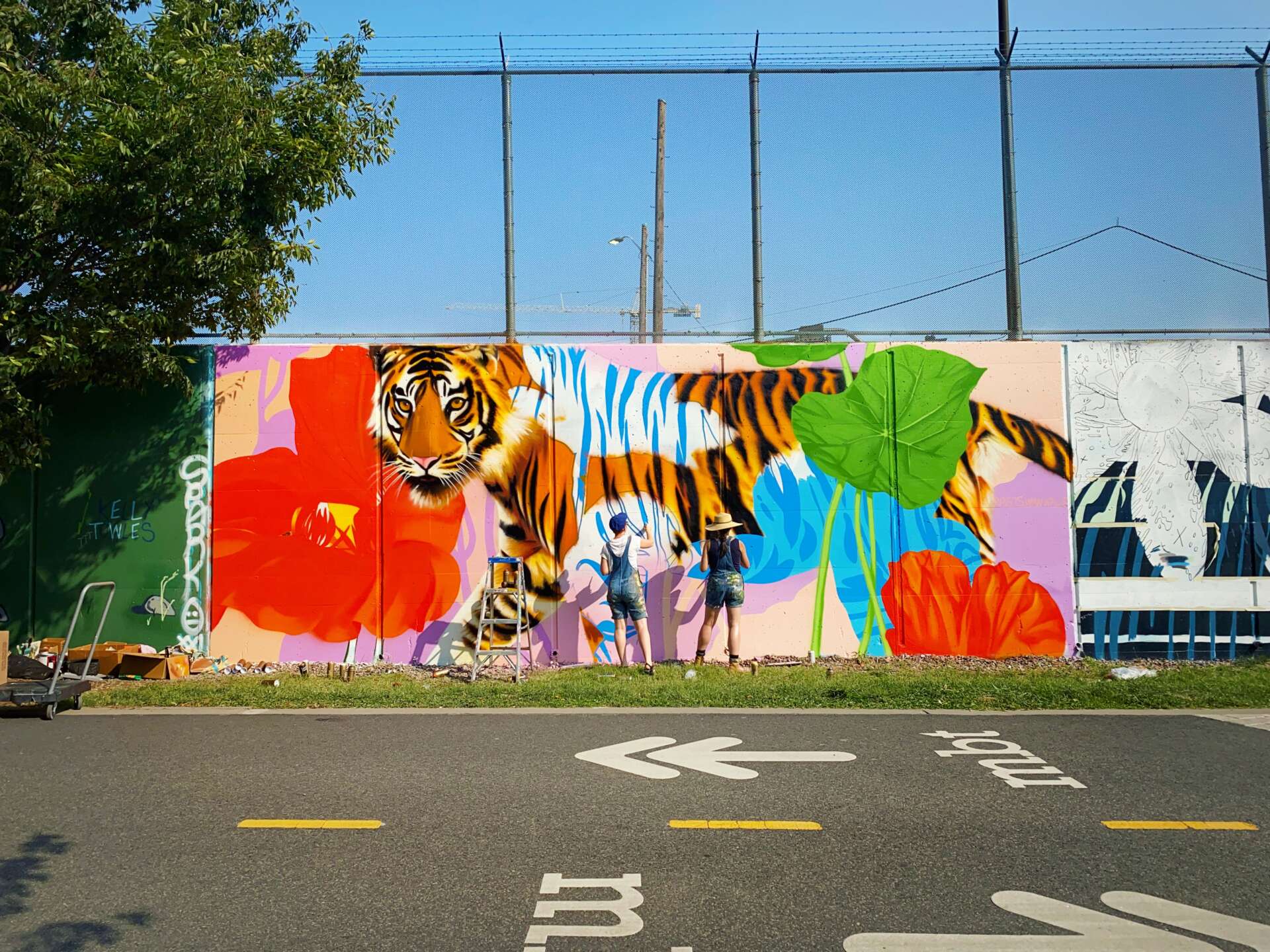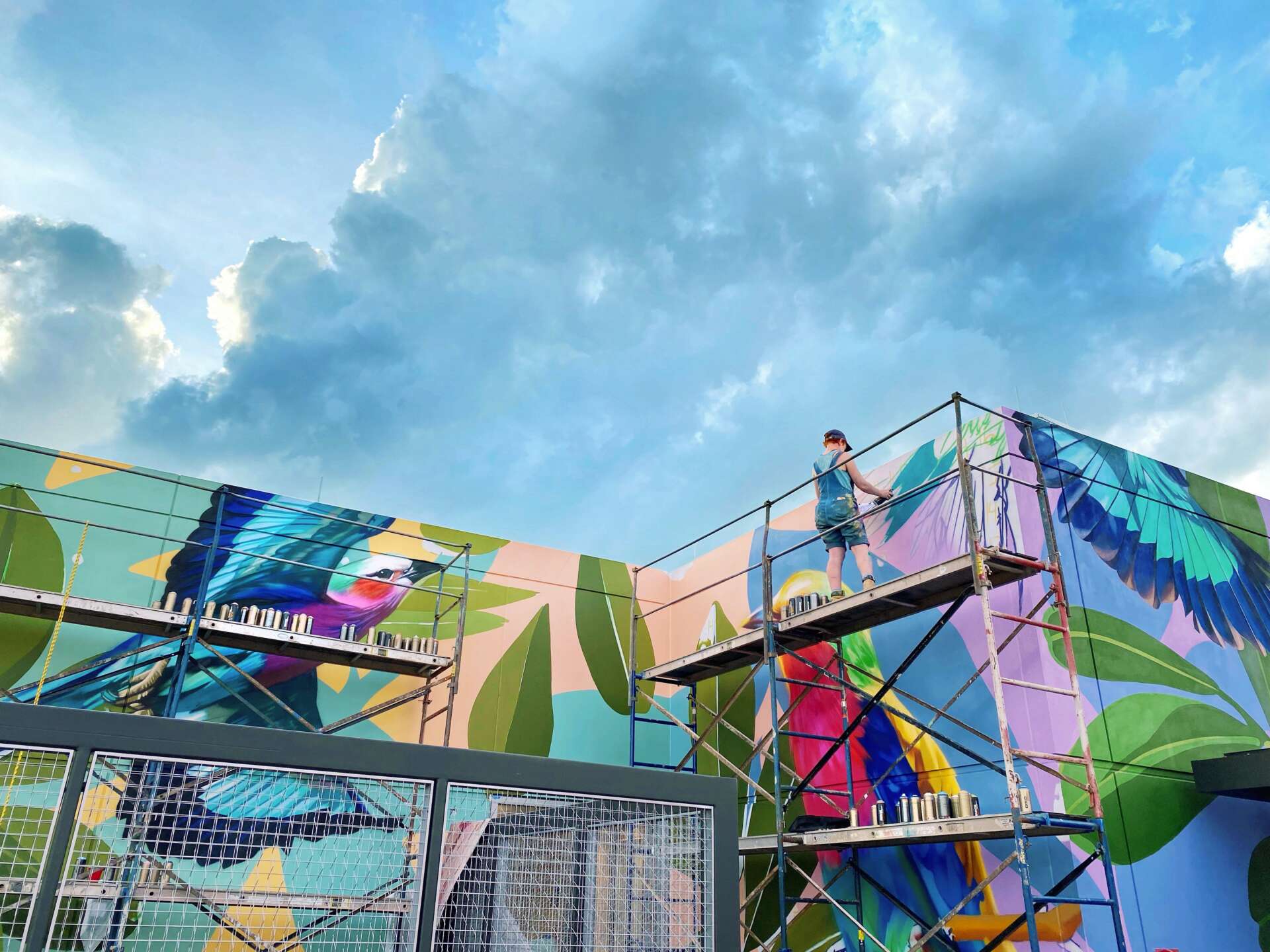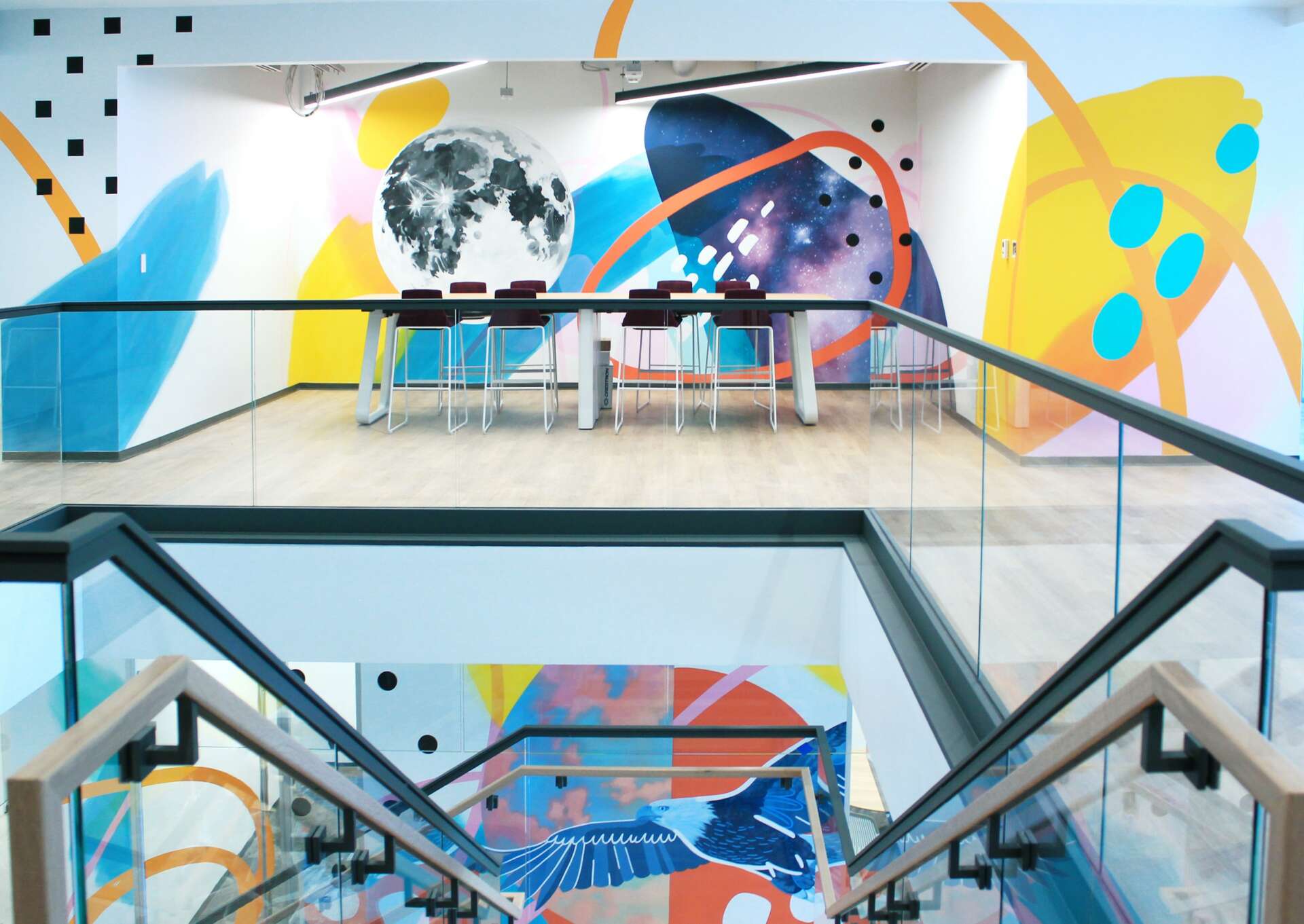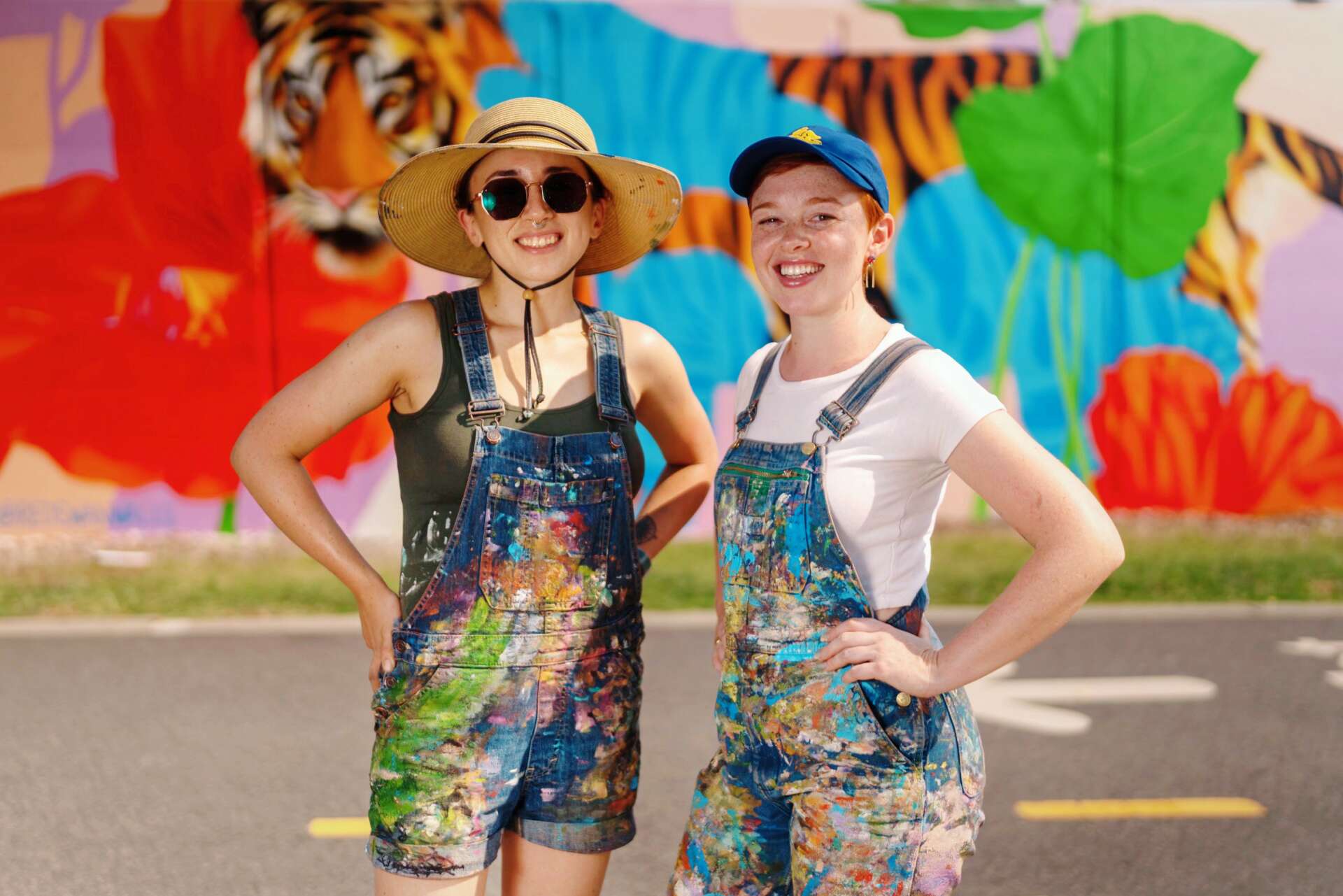We caught up with the brilliant and insightful Red Swan a few weeks ago and have shared our conversation below.
Alright, Red thanks for taking the time to share your stories and insights with us today. What’s been one of the most interesting investments you’ve made – and did you win or lose? (Note, these responses are only intended as entertainment and shouldn’t be construed as investment advice)
One of the best investments we’ve made in our career has been getting a studio, which just happened earlier this year! We’d been wanting one for years, both to practice in and to have a more collaborative space for working on smaller commissions- in the past, we’d just been passing paintings back and forth between our houses. We ended up springing for a large industrial space with plenty of natural light and big, beautiful blank walls, that we’re filling up much more quickly than anticipated. Having the studio has completely revolutionized our practice, and has allowed us to take on projects that we would’ve passed on previously. It’s emboldened us to say “yes” to jobs that involve processes and materials we’re unfamiliar with.
It’s been amazing to have a space that enables us to experiment, which is really important in our line of work. So much of our job is problem-solving on the fly, and we now use the studio to workshop any problems we think we might run into once we’re on site. The more planning we can do offsite, the faster we can get in and out of job sites, which cuts down on travel time and expenses, and reduces burnout.
On a practical note, it’s made a huge difference when it comes to our supplies situation. We’ve accumulated enough paint and ladders etc. that getting a studio really became necessary from a storage standpoint. Having all of our supplies centralized has made it much easier to keep track of what we have and what we need for different jobs, and has streamlined processes like packing and color-picking.
Generally speaking though, it’s so important to invest in your craft as much as possible! Things like Graco paint sprayers were financially out of reach for a while, but as soon as we could afford them, we got them, and it really leveled up our practice. Now we can confidently design murals with large gradients in them, and have the tools to execute them seamlessly. We know that as artists, it’s often really difficult and scary to spend money on things like expensive tools and work spaces, but ultimately you’ll be creating a better product for your client, and a better piece for your portfolio!



Great, appreciate you sharing that with us. Before we ask you to share more of your insights, can you take a moment to introduce yourself and how you got to where you are today to our readers.
Red Swan is a women-owned mural studio based in Baltimore. It’s just the two of us- Hanna Moran and Lindy Swan. We both come from fine art backgrounds, and worked primarily in oil paint prior to painting murals. I don’t think either of us really saw mural painting as a career path until we started working together and really clicked. We met back in 2014, when we were both painting murals in schools for a small mural studio based in Baltimore county. It was a great job but we weren’t especially passionate about most of the projects. The murals were really curriculum heavy, and no one saw our work beyond the students and teachers. We slowly started to branch out into more public art, and fell in love with the work.
As a studio, we take on a wide range of projects, from more corporate office murals and bespoke designs for businesses and nonprofits, to large-scale public art. We love that our job can feel so different week to week. We’re so lucky to be meeting new people, working with amazing organizations we admire, and to be able to work in different styles and with fresh subject matter from project to project.
That being said, if money wasn’t a factor, we would probably focus more on public, outdoor murals. When left to our own devices, we design murals featuring large scale flora and fauna, with colorful, abstract backgrounds. We love bringing unexpected and joyful imagery to public spaces, and making art accessible to a wider audience.



Can you share a story from your journey that illustrates your resilience?
So much of being a working artist is about resilience! One example that immediately comes to mind is a mural festival we did in 2020. We were lucky enough to be granted the largest wall at the festival that year, but didn’t fully understand how large it was until we got on site. Side note- it’s almost always worth doing a site visit!
We had planned on doing the entire mural in house paint, which was pretty much the only medium we’d used up until that point. But the wall ended up being around 40 by 150 ft, and after one day of trying to get as much house paint on the wall as we could, we realized that it was absolutely not going to work within our given time frame. It was simply too slow. So we went out and bought a bunch of spray paint, and basically taught ourselves how to use it on that job. It was so far out of our comfort zones, and a real trial by fire situation. We weren’t just learning how to get clean lines in spray- which we also didn’t know how to do- but we were figuring out how to render realistic birds and flowers. To be honest, we were completely terrified that this very public mural would be a complete flop, both for us and the festival. But after 8 long days- and nights, painting by spotlight, we’d completed a mural that we were so incredibly proud of, and learned so much in the process. Shout out to the festival organizer and support crew for keeping us going, and for trusting us- more than we trusted ourselves- to pull it out in the end! The whole process was such a formative experience, and it’s still one of our favorite murals to date!


In your view, what can society to do to best support artists, creatives and a thriving creative ecosystem?
The number one thing society can do to support artists is paying them fair rates! We’re sick of the “starving artist” trope, and of having our small business treated as a cute hobby. There’s a common sentiment that if artists are doing what they love and following their passions, then why would they need to be paid? Yes, we are lucky enough to find our job to be rewarding, but a LOT of work goes into being an artist on a professional level. The reality is that this job is maybe 10% pure fun, 90% labor.
As muralists, so much of our daily grind is emails and zoom calls, just like people with office jobs. It’s going back and forth with clients over design edits, coordinating with site managers, juggling construction schedules, and problem-solving on short deadlines. Then there’s the physically exhausting part- working long days in the blazing sun, climbing up and down ladders and scaffolding, and sweating through our overalls. We’re slowly but surely giving ourselves carpal tunnel from gripping our paint brushes and pressing down on spray caps. What makes it all worth it is that moment that a design truly comes into its own, or a color combo goes on a wall juuust right. That’s our fun, but it’s not our payment. We love those magical moments, but like everyone else, we also love financial stability, and being able to pay our bills on time.
One more point- we’ve definitely realized that while people generally trust other professionals to set their prices, artists are constantly questioned for charging fair rates. If you wouldn’t ask a mechanic or electrician to do the job for half the price they quoted, don’t ask an artist to.
Contact Info:
- Website: www.redswanwalls.com
- Instagram: @redswanwalls
Image Credits
Most photos were taken by us, so no credit needed. But the portrait was taken by Ian Roche, and Orioles photo (with jerseys) was taken by Bilal Johnson-Bey


